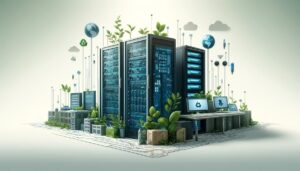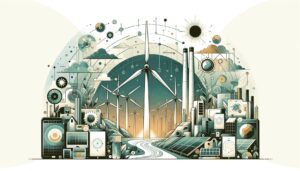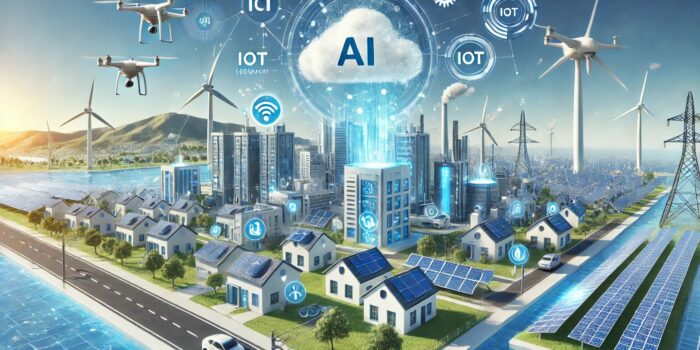Imagine walking through a city where the air is clear, the buildings are powered by the sun, and technology harmonizes with nature. This vision, once a distant dream, is becoming increasingly attainable thanks to the fusion of technology with sustainable practices. Today, in every corner of our world, the effects of climate change are evident, nudging humanity towards more responsible and environmentally-friendly technologies.
In this crucial era, the tech industry is not just an observer but a pivotal player in the journey towards a sustainable future. This blog post presents the Green IT and sustainable technologies, exploring how recent advancements are reshaping the tech industry’s approach to environmental responsibility. We will travel through the world of AI-powered energy efficiency, eco-conscious computing practices, renewable energy in tech, and the sustainability of cloud computing, uncovering the groundbreaking strides being made towards a greener tomorrow.


AI’s Role in Energy Efficiency
The marvel of AI extends far beyond virtual assistants and automated customer service. In the field of energy efficiency, Ai is emerging as a transformative force, markedly reducing the carbon footprint associated with technology operations.
- DeepMind AI in Data Centers: At the forefront is Google’s implementation of DeepMind AI in its data centers. The AI’s ability to optimize cooling systems resulted in a staggering 40% reduction in energy usage. This is not just a win for Google but a beacon for data centers globally, demonstrating the potential of AI in large-scale energy conservation. This innovation is a part of Google’s broader sustainability efforts, as outlined in their recent sustainability report.
- AI in Renewable Energy Optimization: Beyond cooling systems, AI is making waves in the renewable energy sector. One standout example is its application in wind farms, where AI algorithms predict power output, enabling more efficient energy use. Such technologies not only optimize renewable energy but also bridge the gap between sustainable practices and operational efficiency.
- Case Study: Consider a smaller tech company that implemented AI to manage its energy consumption. Despite initial challenges, such as integrating AI with existing systems and the need for initial investment, the company saw a significant reduction in energy costs and carbon emissions. This case study, reflective of many others in the industry, underscores the accessibility and impact of AI in energy efficiency for businesses of all sizes.
The Emergence of Green Computing
The concept of green computing has evolved from a niche idea into a fundamental strategy for technological advancement. This shift marks a crucial step in the tech industry’s path towards environmental stewardship.
- Eco-Friendly Tech Hardware: Dell’s latest sustainability initiatives provide a prime example of eco-conscious manufacturing in action. By integrating recycled materials in their products, Dell not only promotes recycling but also drives forward the concept of a circular economy in tech manufacturing. Such practices not only minimize environmental impact but also set a precedent for sustainable product life cycles in the tech industry. By 2030, Dell proposes that for every metric ton of our product a customer buys, one metric ton will be reused or recycled. Also, by 2030 100% of their packaging will be made from recycled or renewable material, or will utilize reused packaging and more than half of their product content will be made from recycled, renewable or reduced carbon emissions material.
- Data Center Efficiency: A recent study indicates a remarkable trend: despite the exponential growth in global computing demand, the energy consumption in data centers has not kept pace, thanks to significant efficiency improvements. This decoupling of energy use from computing growth highlights the industry’s commitment to minimizing its carbon footprint while meeting the ever-growing demand for digital services.
Powering Technology with Renewable Energy
The integration of renewable energy in the tech sector is not just about reducing carbon emissions; it’s a bold statement about the sector’s role in combating climate change.



- Apple’s Renewable Energy Milestones: Apple’s recent reports reveal their achievement in transitioning to 100% renewable energy for all their operations. This move is more than a corporate milestone; it’s a message to the world about the potential and importance of renewable energy in large-scale operations. They are laser-focused on their commitment to
achieve carbon neutrality for their entire footprint by 2030. Today, 213 of their suppliers, representing the majority of Apple’s direct supplier spend, are committed to using 100% renewable energy for their Apple business. In the last year, they more than doubled the amount of clean energy used to manufacture Apple products. - Amazon’s Green Initiatives: Amazon’s commitment to reach net-zero carbon emissions by 2040, and its interim goal of 100% renewable energy, underscores the tech giant’s role in advocating for environmental responsibility. Amazon’s initiatives demonstrate that sustainability can be integrated into every aspect of a business, from energy sourcing to product delivery.
The Sustainable Cloud
As cloud computing becomes the backbone of modern tech infrastructure, its role in sustainability becomes increasingly significant.
- Sustainable Practices in Cloud Computing: Cloud providers like Google Cloud and Microsoft Azure are making concerted efforts to minimize the environmental impact of their services. These companies are adopting strategies like using renewable energy and optimizing data centers for energy efficiency, proving that cloud computing can be a powerful tool for sustainability.
- Impact on SMEs: The shift towards sustainable cloud services has a particularly profound impact on small and medium enterprises (SMEs). By leveraging cloud services, these businesses can significantly reduce their carbon footprint, demonstrating that sustainability is accessible and beneficial for companies of all sizes.
Embracing the Future: How Sustainable Technologies are Redefining Tech’s Tomorrow
The conclusion emphasizes that embracing Green IT and sustainable technologies is a significant shift towards a sustainable future, going beyond corporate responsibility to positively impact society and the environment. This approach fosters innovation in harmony with ecological needs and offers economic benefits like enhanced brand reputation and compliance with environmental regulations. Additionally, it contributes to a healthier environment and a higher quality of life, underscoring the belief that technology should be a force for positive environmental and social change.





